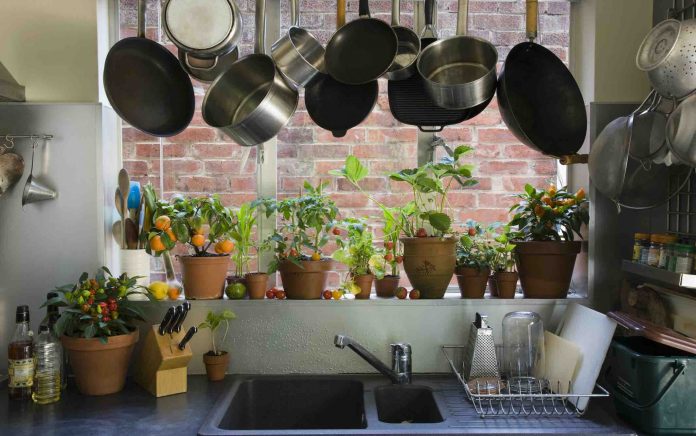
How would you like to breathe easier and cleaner at home or in your office? You can do so by adding some selected house plants to your environment. Certain house plants are better than others at adding oxygen to your living space and improving the overall air quality in that space.
House plants clean the air
The science behind this suggestion has been around for decades and actually started with a trio of investigators with NASA and the Associated Landscape Contractors of America. They reported that specific house plants were good at removing off-gassing elements from building materials and furnishings as well as air pollutants.
Read about houseplants as indoor air purifiers
Plants are a natural air purifier because they produce oxygen from carbon dioxide (which you exhale) while also helping remove toxins from the air. They perform this function not because they are concerned about our health but because it is what they do. Tiny openings in the leaves take in air, and the plant absorbs the carbon dioxide and other substances from that air.
While the plant uses carbon dioxide to make food, it then releases oxygen and water back into the air. Pollutants, on the other hand, are translocated to the roots of the plant, where they may be broken down, used by the plant, or released into the soil.
The use of plants to remove harmful elements from the air is called phytoremediation. If you want to breathe easier at home or at work, feel good about the air your breathe, and know you are providing yourself and your family with better air quality, then consider adding one or more of the following air-purifying plants to your home or office space. We will even tell you how to make that plant flourish so you can reap the most benefits from it.
Which house plants clean the air
Aloe vera: This succulent is probably best known for its ability to help in the treatment of burns and cuts. However, it also takes in benzene and formaldehyde. If you want a healthy aloe vera, keep it in a sunny place. It also should be planted in a pot with many drainage holes, because the plant does not do well in standing water.
Areca palm: This tropical plant can live in just about any indoor environment. It has broad fronds that are adept at absorbing formaldehyde, toluene, and xylene. Be aware, however, that the areca palm can top 7 feet in height. If you purchase a small plant, it will grow about 6 to 10 inches a year in indirect sunlight. These plants do enjoy water and fertilizer.
Bamboo palm: This plant loves the tropics as well as bright, indirect sunlight. Placing the bamboo palm in your environment will help remove trichloroethylene, a toxin that can damage the kidneys and liver.
Care for your bamboo palm by watering it when the soil is dry. Never overwater the palm or let it sit in water or it will rot.
Boston ferns. This frond-rich plant not only helps improve oxygen levels. The Boston fern also assists in removing formaldehyde from the air. Exposure to formaldehyde is associated with irritation to the eyes, nose, and throat, which suggests having a few Boston ferns in any area prone to formaldehyde exposure could be helpful. Items associated with formaldehyde exposure include cigarettes, carpet, permanent press fabrics, cleaning agents, fertilizers, cosmetics, paints, varnishes, preserved foods, and insulation for electrical uses.
If you welcome a Boston fern into your environment, be prepared to give it a lot of space. The beautiful fronds enjoy soil that is rich in peat moss and is watered frequently and stays wet. You also should mist the plant once or twice a week for best growth.

Gerber (aka, Gerbera) daisies: If you like to color-coordinate your space, then Gerber daisies could be a good choice. These flowers are available in a variety of colors (e.g., bright red or orange, yellow, medium and striking pink, peach, light purple, and white) and sport broad, green leaves that absorb benzene, formaldehyde, and trichloroethylene from the air.
Gerber daisies enjoy direct sunlight and moist soil. For best results, don’t allow the soil to dry between waterings.
Read about 7 ways to improve indoor air quality at home
Peace lilies: Do you know which pollutants are lurking in your home or office? If two of them are benzene and trichloroethylene, then it’s time to get some peace lilies.
If you want to grow this beautiful plant, you should know they do not tolerate the cold and that they enjoy a warm, humid climate. They thrive in well-draining soil and indirect light.
Snake plant (aka, mother-in-law’s tongue). The snake plant comes in a combination of yellow and dark and light greens. It effectively removes formaldehyde, benzene, toluene, xylene, and trichloroethylene from the air. These toxins are often present in enclosed buildings.
This tough plant likes dry soil, so don’t water it too often because the roots can easily rot. Avoid getting the leaves wet when watering. Snake plants prefer indirect light.
Spider plant: If you want a plant that is super resilient and easy to care for, this is the one. Spider plants can absorb many different indoor pollutants while gracing your room with its long, flowing leaves.
Be sure to give your spider plant lots of bright yet indirect light. It does best in well-drained soil and when the soil is allowed to dry out between waterings.
Weeping fig: This official tree of Bangkok will look great and perform well in any room, but especially those with carpeting and furniture that may be off-gassing. That’s because the weeping fig helps remove pollutants from these items.
You can keep your weeping fig healthy by providing consistent temperatures and lots of indirect sunlight. Provide the plant with well-draining soil and only water it when the first 2 inches of soil are dry.
Bottom line
Using house plants in your home or office is a great, eco-friendly way to clean the air of toxins. Let us know which house plants you are welcoming into your bedroom, home, or office!
Sources
Agency for Toxic Substances and Disease Registry. Toxic substances portal—formaldehyde. 2008 Sep
Arnold R. The 10 best plants to improve the air quality of your home. Earth.com
New York Botanical Gardens.
Plant Snap. 5 house plants that produce the most oxygen. 2018 Nov 21
Wolverton BC et al. Interior landscape plants for indoor air pollution abatement. NASA 1989 Sep 15










